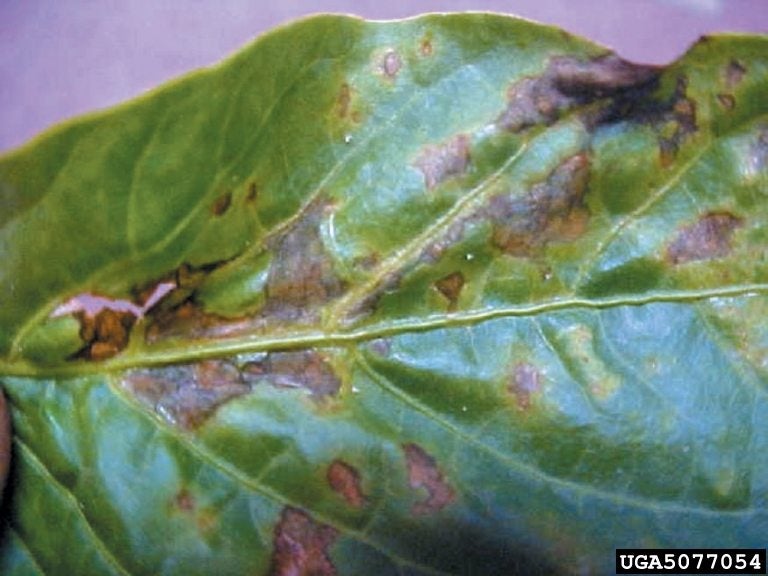Browning Pepper Leaves: Why Are Leaves Turning Brown On Pepper Plants

As with every crop, peppers are susceptible to environmental stress, nutrient imbalances, and pest or disease damage. It’s important to assess the damage and diagnose it immediately in order to formulate a plan of action. One of the more common problems found in peppers is brown pepper plant foliage. Browning pepper leaves may be the result of any of the above. Keep reading to find out what causes a pepper plant with brown leaves and how to remedy leaves turning brown on pepper plants.
Reasons Pepper Leaves are Turning Brown
Browning pepper leaves may be the result of environmental conditions such as frost damage/chilling injury. Usually, this type of injury will encompass the entire plant. That is, not only the leaves, but the entire plant may become discolored and wilted. Also, the inside of any fruit will become brown as well. If leaves are turning brown on your pepper plants, it may also be because you forgot to water them. When leaves get brown and crumble, especially when accompanied by the dropping of leaves and the drooping of the plant, it’s likely that the plant is underwatered. Be sure to water properly and routinely by watering at the base of the plant, deeply once or twice per week, and mulching around it with organic mulch such as straw or shredded leaves. If neither of these seems to be the cause of your pepper leaves turning brown, it’s time to consider some other possibilities.
More Serious Causes of Brown Pepper Plant Foliage
Some insects can result in a pepper plant with brown leaves. Whiteflies, for instance, suck juices from the plant and weaken it, resulting in wilting leaves that turn yellow followed by browning. You’ll know it’s whiteflies if you give the plant a little shake and a cloud of tiny insects flies up. Use Tanglefoot insect barrier spread on a yellow card to trap the whiteflies and spray the plant with insecticidal soap. Another insect that may cause foliage to brown is the thrip. It’s not actually the insect that is causing the discoloration, but a virus called spotted wilt that is spread by it. Keep the area around the plants free from weeds that host thrips and remove any infected leaves or completely destroy severely infected plants. Some fungal diseases may cause foliage to discolor or turn brown. These are spread by splashing water or by tools and your hands as you move around in the garden. Avoid overhead watering and working in the garden when plants are wet from the rain. Don’t plant peppers or tomatoes in the same place more than once in a three- or four-year time period. Spray with copper sulfate at the first signs of infection. Remove severely infected plants and burn them. Clean up all plant debris. The last possible reason for a pepper plant with brown leaves is bacterial spot. This bacterial disease is one of the most destructive diseases of peppers. It initially appears as water-soaked lesions on leaves that turn brown and irregular in shape. The spots appear raised on the underside of the leaves and sunken on the upper side. Affected leaves then yellow and drop. Fruit may have raised scab-like spots or water-soaked lesions that turn brown. Bacterial leaf spot is transmitted on infected seeds and transplants grown from infected seed. There is no known cure. Prune away infected leaves and practice good sanitation in the garden and with tools. If plants appear to be severely infected, remove and destroy the plants.
Gardening tips, videos, info and more delivered right to your inbox!
Sign up for the Gardening Know How newsletter today and receive a free copy of our e-book "How to Grow Delicious Tomatoes".

Amy Grant has been gardening for 30 years and writing for 15. A professional chef and caterer, Amy's area of expertise is culinary gardening.
-
 Looking For Plants To Give You The Soft And Fuzzies? Try These 5 Fuzzy Leaf Plant Options
Looking For Plants To Give You The Soft And Fuzzies? Try These 5 Fuzzy Leaf Plant OptionsLovers of texture, drama, silver foliage and tactile plants will adore these special sensory garden additions. These fuzzy leaf plant options will leave you all aglow
By Susan Albert
-
 Get Ready For A Summer Of Hummers! Grow These Full Sun Hummingbird Plants and Flowers
Get Ready For A Summer Of Hummers! Grow These Full Sun Hummingbird Plants and FlowersIf you’re lucky enough to enjoy a sunny backyard, make sure you are maxing out on your pollinator opportunities and grow these full sun hummingbird plants and flowers
By Tonya Barnett